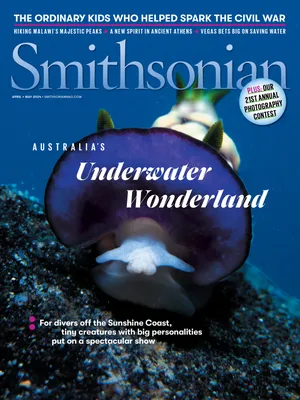Why Aren’t Dolphins in the Great Lakes? And More Questions From Our Readers
You’ve got questions. We’ve got experts
:focal(1050x750:1051x751)/https://tf-cmsv2-smithsonianmag-media.s3.amazonaws.com/filer_public/09/65/096595d4-94be-4d83-b22f-01ef67d4ffb8/untitled-1.jpg)
Why aren’t there freshwater seals or dolphins in the Great Lakes? Kurt Petersen | Sheboygan Falls, Wisconsin
The Great Lakes started to form about 10,000 years ago as glaciers began to retreat, and they reached their present state 3,000 years ago. This is very recent in the context of evolution. Niagara Falls kept cetaceans and seals from colonizing most of the Great Lakes; however, there is evidence from historical records that harbor seals did inhabit Lake Ontario and Lake Champlain up into the early 1800s but were hunted to extinction there. Marine mammals are known to occur in the tidal segments far up the St. Lawrence River. Currently the largest semiaquatic mammal in the Great Lakes is the North American river otter. —Michael McGowen, curator of marine mammals, National Museum of Natural History
You recently featured an Islamic painting that depicted humans. Isn’t this forbidden? Carole Ann Concors | Louisville, Kentucky
Debates around figural imagery stem from the basic belief in Islam that God alone is responsible for creating living forms. While the Quran disapproves of three-dimensional forms, condemnation of two-dimensional representation appears in the Hadith (Traditions), composed after the Prophet Muhammad’s death. Figural imagery, however, has existed in many parts of the Islamic world since Islam’s inception in the seventh century. These images are confined to secular contexts; for example, objects intended for eating, drinking or storing. Along with calligraphy and geometric or floral ornamentation, they embellish buildings, objects and textiles, and are integrated into literary, scientific and historical manuscripts. —Massumeh Farhad, curator of Islamic art, National Museum of Asian Art
How did the Canadian accent develop? Johnson Alabama Kanell | Portland, Maine
In the “Canadian raising” you hear in words like “about,” certain vowels get higher before voiceless consonants, such as “p,” “t” and “k.” This change probably started with the influx of British Loyalists after the American Revolution and spread as they moved west. When several vowels change in a language, it puts pressure on other vowels to change as well. So now we can hear a more general shift, where many vowels are pronounced higher and farther back in the mouth. Not all Canadians speak this way, and several parts of the United States (the upper Midwest and areas of Boston, for example) have a raising as well. —Mary Linn, curator of linguistic revitalization, Smithsonian Center for Folklife and Cultural Heritage
How do we measure Earth’s diameter? Lucas Zheng | Lexington, Massachusetts
The Earth’s circumfrence was first calculated in 200 B.C. by the Greek mathematician Eratosthenes, based on the length and angles of shadows between the Egyptian cities of Alexandria and Syene. His result would put the polar diameter at 7,850 miles—only 50 miles shy of the actual polar diameter! Unlike Eratosthenes, we now know that Earth is not a perfect sphere. Its diameter changes slightly depending on your latitude. Today, satellites can analyze distances along with gravitational fields and light waves to get precise measurements. But it’s incredible that Eratosthenes was able to get so close. —James T. Haber, Earth and planetary sciences fellow, National Air and Space Museum
